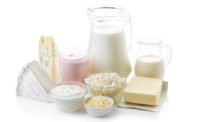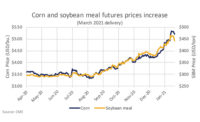
Bullish on Butter
by Julie Cook
Despite skyrocketing prices, butter processors remain
optimistic about the category.
Putting a spin on the old Blood, Sweat & Tears
classic, “Spinning Wheel,” what comes down must go up.
That’s exactly what’s happened in the butter category, where
last year’s comfortably low prices have become just a vague memory.
In recent months, prices have risen rapidly, surging
from $1.39 per pound on January 5 to $2.36 on March 25. One year ago, that
figure stood at $1.09, a disparity that has led processors to be
understandably concerned.
“The market has accelerated in the past two months to unprecedented
levels, so everything in terms of costs has accelerated very rapidly as well,”
says Tom Hickey, marketing manager, Level Valley Creamery, West Bend, Wis. “The
butter market is the highest it’s ever been this early in the year, and there’s
a lot of trepidation as to what the supply of milk is going to be over the summer
months and into the fall when everybody’s demands increase dramatically.”
According to Hickey and others, some retailers try to
manage such price fluctuations by “playing the market.” That
is, they build up their inventories while prices are low so they will be
able to meet demand without raising prices during times of crisis. This
tactic may be a wise one, as butter demand has remained high so far.
According to data from Chicago-based Information Resources Inc. (IRI) for
the 52-week period ending March 21, 2004, unit sales of butter in
supermarkets, drugstores and mass merchandisers, excluding Wal-Mart,
dropped just 1.1 percent.
Still, “retail sticker shock” is bound to
hit consumers in the near future, says Jed Davis, director of marketing,
Cabot Creamery Cooperative, Cabot, Vt. But he’s encouraged by the
continued strong demand for butter, which he sees as evidence that the
American food industry has finally fully rebounded from the setback it
suffered following the 2001 terrorist attacks.
Growing awareness of the dangers of trans-fatty acids, present
in most margarines and spreads, has helped many consumers recognize the benefits
of sticking with real dairy butter, according to Debbie Boyce, director of foodservice
and retail sales, Odell’s, Reno, Nev. Indeed, IRI data shows high pricing has
not resulted in any sort of mass exodus from butter to other alternatives, as
unit sales of margarine, spreads and butter blends fell 6.3 percent during the
same 52-week period.
“As there’s more consumer awareness of the
health impact of those types of alternatives, consumers will be hesitant to
move away from butter, which is an all-natural product that doesn’t
have trans-fats or hydrogenated oils,” says Boyce.
Some processors cite the Atkins diet craze as another
factor contributing to the continued strong demand for butter. While it
certainly seems logical that a diet promoting the consumption of high-fat
animal products would boost interest in butter, a closer examination
reveals the whole low-carbohydrate trend is actually a double-edged sword.
On the one side, weight-conscious consumers are no longer afraid of fat
and, thus, more willing to incorporate such previously taboo foods as
butter into their diet. At the same time, many of butter’s most
popular carriers, such as bread and baked potatoes, are deemed no-nos for
Atkins enthusiasts.
On the foodservice side, previous spikes in butter
pricing have caused restaurateurs and food manufacturers to seek out
alternatives to butter. This time around, however, processors report they
have not witnessed such a trend. In fact, Hickey reveals that sales of
Level Valley’s butter/vegetable oil blend product have not increased
as expected. In part, he credits high soybean prices for keeping demand for
such products low and, thus, enabling operators and manufacturers to stick
with butter.
Blurring the Line
Granted, processors must do their part to give
consumers reasons to stick with butter. For a category in which innovation
doesn’t come naturally, however, flexing one’s R&D muscle
hasn’t been easy. That said, industry groups like the American Butter
Institute have long been aware of the issue that presents the greatest
opportunity for processors.
“One of the largest complaints we’ve always had about butter
is that it’s not spreadable,” says Jerry Kozak, executive director of the Arlington,
Va.-based organization. “Anybody who has ever tried to microwave butter to get
it soft right from the refrigerator has found they can’t seem to get it down
just right.”
Responding to those consumer needs, top branded butter maker
Land O’Lakes, Arden Hills, Minn., recently introduced two new products — Land
O’Lakes® Soft Baking Butter with Canola Oil and Land O’Lakes Spreadable Butter
with Canola Oil. By adding oil to the mix, Land O’Lakes has accomplished its
goal of providing customers with products that are spreadable straight from
the refrigerator. While the Spreadable Butter allows consumers to more readily
use the product on bread, pancakes and other foods, spokesperson Lydia Botham
says the Soft Baking Butter has opened new doors for home bakers, frustrated
by the limitations of traditional butter.
“When baking cookies, if you over-soften the butter, your cookie
dough tends to be too warm, so it spreads quickly in the oven and you get these
flat cookies,” she explains. “With this new product, you just take it out of
the refrigerator, put it in your mixing bowl and, in about 20 minutes, you’ve
got a batch of fresh cookies made from scratch.”
Not everyone is so enthusiastic about these strategies
for making butter more consumer-friendly. Hickey expresses concern over the
potential confusion such products could cause in the marketplace if
consumers fail to understand that “spreadable” products are not
pure butter. Meanwhile, Joe Fallon, vice president of marketing,
Keller’s Creamery LLC, Harleysville, Pa., feels processors are
“blurring the line between butter and non-butter products” and
risking the integrity of butter in the process.
As for Land O’Lakes, Botham argues the company was very clear
in naming the two products, stating upfront that they are butters “with canola
oil,” so consumers will know exactly what they are getting. Because they contain
zero trans-fatty acids and eliminate the spreading problems of traditional butter,
Botham is confident consumers will react positively to them.
“These are definitely exciting additions to the
category because there hasn’t been a lot of innovation over the past
few years,” she says.
Land O’Lakes may find itself with some stiff
competition in the form of Silver Spread, a newly developed all-natural
alternative that boasts the taste and mouthfeel of a full-fat spread, but
with 70 percent less fat and 60 percent fewer calories than butter or
margarine. Free of chemicals, emulsifiers and preservatives, Silver Spread
is manufactured exclusively from milk and dairy byproducts, and has been classified by the Food and
Drug Administration and the U.S. Department of Agriculture as a light butter. Although it contains no hydrogenated oils or trans-fatty acids, the product spreads directly from the refrigerator and is suitable for baking and cooking.
is manufactured exclusively from milk and dairy byproducts, and has been classified by the Food and
Drug Administration and the U.S. Department of Agriculture as a light butter. Although it contains no hydrogenated oils or trans-fatty acids, the product spreads directly from the refrigerator and is suitable for baking and cooking.
“It’s quite distinctive from anything else on the market,” says
Jules Silver, president of Silver Research Inc., the Boca Raton, Fla.-based
development company that formulated the product with the assistance of Rosemont,
Ill.-based Dairy Management Inc. “It’s really the ideal product both from a
health standpoint and from a farmer’s benefit standpoint.”
For Odell’s, the focus has been on bringing its foodservice
butters to the retail market. The company offers a 100 percent natural clarified
butter, sold using the tagline, “For cooking, for baking, for flavor,” as well
as its Chef’s Butter line of shelf-stable “seasoned finishing butters” in flavors
such as Basil Pesto, Garlic Herb and Steakhouse.
Cabot rolled out a “baby-pack” version of
its salted quarters, containing two sticks per carton instead of four.
Keller’s, meanwhile, introduced a new package for its popular
Falfurrias butter. Designed to appeal to the burgeoning Hispanic-American
population, it features both English and Spanish text. “It’s a
brand that has a very strong Hispanic following, so we’re catering to
that market and acknowledging that market very strongly,” says
Fallon.
While some consumers remain stringently brand loyal,
private label products account for 50 percent of retail butter sales. This
trend could be considered a negative in that it perpetuates the
“commodity” image many dairy products, including butter, have
fought to shed. But many processors believe private label actually may
enable some consumers to stick with butter during times of high pricing
because they can temporarily switch to a value-priced store brand and then
return to their branded favorite once prices calm down.
“As the market goes higher and you see retails on butter all
over three dollars, people are going to be reluctant to choose the brand,” says
Hickey. “When they see that the private label alternative is at least 40 to
50 cents less per package, they are going to be far more likely to put that
product into their grocery cart.”
Julie Cook is a freelance journalist based in the Chicago
area.
| Top 10 Butter Brands* | |||||
| $ Sales (In Millions) |
% Changevs. Year Ago |
Dollar Share |
Unit Sales (In Millions) |
% Change vs. Year Ago |
|
| Total Category | $478.2 | -1.1 | 100.0 | 446.2 | -1.0 |
| Private Label | 236.7 | -3.4 | 49.5 | 231.0 | -3.6 |
| Land O’Lakes | 125.3 | -3.4 | 26.2 | 112.7 | -2.0 |
| Challenge | 18.7 | 3.8 | 3.9 | 15.3 | 5.0 |
| Crystal Farms | 9.8 | 16.2 | 2.1 | 9.5 | 17.1 |
| Tillamook | 9.1 | 17.5 | 1.9 | 9.1 | 17.5 |
| Kellers | 8.5 | 12.8 | 1.8 | 8.1 | 11.7 |
| Breakstone | 13.4 | 1.4 | 2.8 | 7.2 | 2.3 |
| Hotel Bar | 7.5 | 13.4 | 1.6 | 6.7 | 10.3 |
| Cabot | 5.1 | 14.2 | 1.1 | 5.1 | 14.2 |
| Darigold | 4.1 | -13.1 | 0.9 | 4.0 | -12.7 |
| * Total sales in supermarkets, drug stores and mass merchandisers, excluding Wal-Mart, for the 52-week period ending March 21, 2004.SOURCE: Information Resources Inc. | |||||
| Top10 Margarine/Spreads/Butter Blend Brands* | |||||
| $ Sales (In Millions) |
% Change vs. Year Ago |
Dollar Share |
Unit Sales (In Millions) |
% Change vs. Year Ago |
|
| Total Category | $861.5 | -6.3 | 100.0 | 1,077.4 | -6.3 |
| Shedds Country Crock | 100.0 | -2.3 | 11.6 | 194.0 | -3.3 |
| Private Label | 116.6 | -5.0 | 13.5 | 166.9 | -4.6 |
| Blue Bonnet | 93.8 | -13.9 | 10.9 | 115.2 | -11.9 |
| Can’t Believe It’s Not Butter | 109.2 | -8.2 | 12.7 | 110.5 | -8.7 |
| Parkay | 73.5 | -9.4 | 8.5 | 81.0 | -9.3 |
| Imperial | 73.0 | -7.1 | 8.5 | 81.0 | -9.3 |
| Land O’Lakes | 47.2 | 15.9 | 5.5 | 44.4 | 9.0 |
| Country Crock Churn Style | 19.2 | -12.5 | 2.2 | 40.0 | -7.5 |
| Fleischmanns | 34.4 | -11.9 | 4.0 | 34.3 | -11.6 |
| Can’t Believe Light | 30.7 | -15.8 | 3.6 | 32.5 | -15.6 |
| * Total sales in supermarkets, drug stores and mass merchandisers, excluding Wal-Mart, for the 52-week period ending March 21, 2004. SOURCE: Information Resources Inc. | |||||





